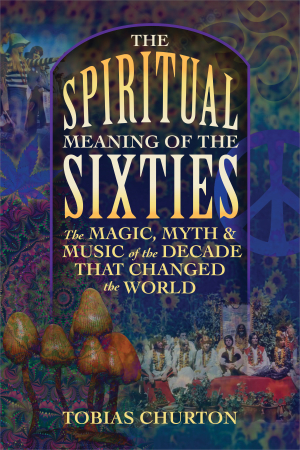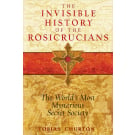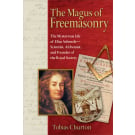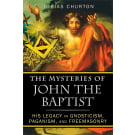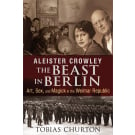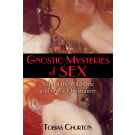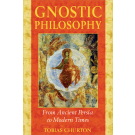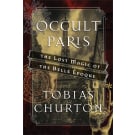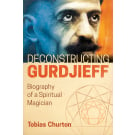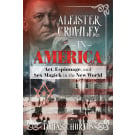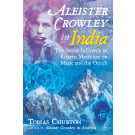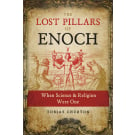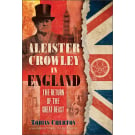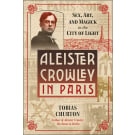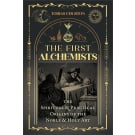The Spiritual Meaning of the Sixties
The Magic, Myth, and Music of the Decade That Changed the World
By (Author) Tobias Churton
Availability:
In Stock
- Pages: 672
- Book Size: 6 x 9
- ISBN-13: 9781620557112
- Imprint: Inner Traditions
- On Sale Date: November 27, 2018
- Format: Paperback Book
- Illustrations: 118 b&w illustrations
Esoteric scholar Tobias Churton explores the origins of the spiritual principles that fueled the artistic, political, and social revolutions of the Sixties. Well known books, films, and music of the era are discussed in light of re-emerging spiritual values.
Unveils the spiritual meaning that fueled the artistic, political, and social revolutions of the 1960s
• Investigates the spiritual principles that informed everything from the civil rights and anti-war movements, to the hippies’ rejection of materialist culture, to the rise of feminism, gay rights, and environmentalism
• Reveals how medieval troubadours, Gnosticism, Renaissance hermetic magic, and the occult doctrines of Aleister Crowley helped shape the psychedelic Sixties
• Offers in-depth analysis of many of the era’s most famous books, films, and music
No decade in modern history has generated more controversy and divisiveness than the tumultuous 1960s. For some, the ‘60s were an era of free love, drugs, and social revolution. For others, the Sixties were an ungodly rejection of all that was good and holy. Embarking on a profound search for the spiritual meaning behind the massive social upheavals of the 1960s, Tobias Churton turns a kaleidoscopic lens on religious and esoteric history, industry, science, philosophy, art, and social revolution to identify the meaning behind all these diverse movements.
Engaging with views of mainstream historians, some of whom write off this pivotal decade as heralding an overall decline in moral values and respect for tradition, Churton examines the intricate network of spiritual forces at play in the era. He reveals spiritual principles that united the free love movement, the civil rights and anti-war movements, the hippies’ rejection of materialist culture, and the eventual rise of feminism, gay rights, and environmentalism. He traces influences from medieval troubadours, Gnosticism, Hindu philosophy, Renaissance hermetic magic, and the occult doctrines of Aleister Crowley. He also examines the psychedelic revolution, the genesis of popular interest in UFOs, and the psychological consequences of the Bomb and the assassinations of the Kennedys and Martin Luther King. In addition, Churton investigates the huge shifts in consciousness reflected in the movies, music, art, and literature of the era--from Frank Sinatra to the Beatles, from I Love Lucy to Star Trek, from John Wayne to Midnight Cowboy--much of which still resonates with the youth of today.
Taking the reader on a long strange trip from crew-cuts and Bermuda shorts to Hair and Woodstock, from liquor to psychedelics, from uncool to cool, and from matter to Soul, Churton shows how the spiritual values of the Sixties are now reemerging, with an astonishing influx of spiritual light, to once again awaken us.
• Investigates the spiritual principles that informed everything from the civil rights and anti-war movements, to the hippies’ rejection of materialist culture, to the rise of feminism, gay rights, and environmentalism
• Reveals how medieval troubadours, Gnosticism, Renaissance hermetic magic, and the occult doctrines of Aleister Crowley helped shape the psychedelic Sixties
• Offers in-depth analysis of many of the era’s most famous books, films, and music
No decade in modern history has generated more controversy and divisiveness than the tumultuous 1960s. For some, the ‘60s were an era of free love, drugs, and social revolution. For others, the Sixties were an ungodly rejection of all that was good and holy. Embarking on a profound search for the spiritual meaning behind the massive social upheavals of the 1960s, Tobias Churton turns a kaleidoscopic lens on religious and esoteric history, industry, science, philosophy, art, and social revolution to identify the meaning behind all these diverse movements.
Engaging with views of mainstream historians, some of whom write off this pivotal decade as heralding an overall decline in moral values and respect for tradition, Churton examines the intricate network of spiritual forces at play in the era. He reveals spiritual principles that united the free love movement, the civil rights and anti-war movements, the hippies’ rejection of materialist culture, and the eventual rise of feminism, gay rights, and environmentalism. He traces influences from medieval troubadours, Gnosticism, Hindu philosophy, Renaissance hermetic magic, and the occult doctrines of Aleister Crowley. He also examines the psychedelic revolution, the genesis of popular interest in UFOs, and the psychological consequences of the Bomb and the assassinations of the Kennedys and Martin Luther King. In addition, Churton investigates the huge shifts in consciousness reflected in the movies, music, art, and literature of the era--from Frank Sinatra to the Beatles, from I Love Lucy to Star Trek, from John Wayne to Midnight Cowboy--much of which still resonates with the youth of today.
Taking the reader on a long strange trip from crew-cuts and Bermuda shorts to Hair and Woodstock, from liquor to psychedelics, from uncool to cool, and from matter to Soul, Churton shows how the spiritual values of the Sixties are now reemerging, with an astonishing influx of spiritual light, to once again awaken us.
Chapter Fifteen
The Spiritual in Art in the Sixties: The Age of Space
The Real Icon
Andy Warhol (1928-1987) is not a figure one automatically associates with the spiritual in art in the Sixties, but since his untimely death in 1987, Warhol’s spiritual beliefs and the importance to him personally of his religious upbringing have become a little more widely appreciated.
Raised in Pittsburgh, the Warhol family (originally ethnic Lemkos from what is now northeast Slovakia) attended the Saint John Chrysostom Byzantine (or Ruthenian) Church, an experience whose icons, liturgical music, ritual, and vestments left a lifelong impact. Though using the Byzantine Rite of the Eastern Orthodox Church, the Ruthenian Church was fully recognized by the Roman Catholic Church. Warhol made regular Mass attendances at the Catholic Saint Vincent Farrer church in Manhattan, sitting at the back, and volunteered at New York’s homeless shelters during the busiest times. I rather think that perhaps only a person who had built his inner life on spiritual foundations could have withstood the many outlandish tremors of his “Factory” life in the Sixties and Seventies without going crazy.
Warhol’s silkscreen diptych Marilyn is probably Warhol’s most, forgive me, “iconic” work, and was first rolled off the process in August 1962, just after Marilyn died in suspicious circumstances a day before Warhol’s thirty-fourth birthday. This might give us a clue to what we ought to mean when we use that very much abused and distorted adjective “iconic.”
Warhol’s church experience was one of the richness of Eastern orthodox architecture. The congregation communicants were used to seeing the saints of the Church in painted portraits surrounded by ornate gold decoration. The paintings were called by the Greek word “icons” (Greek ikōn, an “image” or reflection). These images have a special meaning. When one gazes on a religious icon, one is not worshipping the “image.” That would be idolatry, that is, to place an image before the worship of God. Rather one is enjoined to look spiritually through the image, and pray through the image to the spiritual mystery that the image points toward, inwardly toward, as a sign. The sign is the outer manifestation of an inward reality, a reality that is wholly spiritual, eternal. The icon calls us out of this world and toward the kingdom of God. The individual saint is a being who has brought the light of that kingdom to humankind in such a way that their lives have become a sign to the faithful. An “icon” then, is not simply what we have come to know as an image. It is a visual sacrament.
There seems to me no doubt that Warhol was making an ironic comment, and also a sympathetic, perhaps pitying comment, on the materialism of the predominant culture of the United States, very much in tune with his ironic recognition of commercial art as “art” in the fullest sense nonetheless, if we choose to see it that way. The point about commercial art is that it defies originality insofar as it is mere “image reproduced,” duplicated, or as we say now “cloned.”
However, when we come to the silkscreen image of Marilyn we are seeing two things. First, we are seeing Andy Warhol’s personal response to the undoubtedly tragic demise of the Hollywood “sex goddess,” who was nonetheless a living person, a living, enchanting, troubled soul, and not an image at all. He is elevating her memory by turning her manipulated image from the grip of Hollywood image-manipulators to art, while also saying that all we have now of Marilyn is an image, what passes in an unspiritual world as an “icon,” reproducible and disposable. Life has been lost, and yet the image of Marilyn will go on and on, reproduced on film, in magazines, in the imagination, and so on.
Warhol perhaps has even glimpsed something of the transcendent nature of Marilyn’s personal struggle through life. She said shortly before her death that all she and artists like herself wanted was a chance to twinkle, to reveal the inner star, not merely the outer glamor. She felt the image of Marilyn as something suffocating. Now the world would be plastered with that image.
Clearly, Warhol has been struck by the inverse resonance of the Hollywood image with that of the genuine icon. A genuine icon is a window into heaven. The Hollywood image is a commercial image, superficial, often gaudy, essentially flat, but always spiritually opaque. No light is going to flow through this image to the devoted. The image in cinema is projected onto a screen (a silvery or silvered screen to encourage reflection, not penetration).
I think we do the true icon and Andy Warhol immense disservice when we copy the oft-heard word “iconic” and apply it to this and that reproduced picture, object, or individual. As vulgarly employed today, “iconic” is simply a misleading double for “famous” or “well-known” or “powerful.” Today we hear about a performance being “iconic,” a film being “iconic,” a photo being “iconic.” They are simply images that are reproduced and commonly familiar, and that was inherent to Warhol’s “icons” of the famous. (Remember his famous statement on the transience of democratic fame--everyone will be famous for fifteen minutes--the empty transience of the publicly distributed “selfie”; here today, gone tomorrow. It would only be a matter of time before the “star” him- or herself wanted a silkscreen, not as an ironic comment on their “star-value” or fame and cultural prominence, but as a hip portrait, as their image turned into art by the magician artist Andy Warhol. He would be happy to oblige. One can see the wisdom of the act, for spiritual things are spiritually discerned. Warhol was exposing, even profitably and commercially exposing, reflecting modern life back to itself through the artistic prism of genius.
The Spiritual in Art in the Sixties: The Age of Space
The Real Icon
Andy Warhol (1928-1987) is not a figure one automatically associates with the spiritual in art in the Sixties, but since his untimely death in 1987, Warhol’s spiritual beliefs and the importance to him personally of his religious upbringing have become a little more widely appreciated.
Raised in Pittsburgh, the Warhol family (originally ethnic Lemkos from what is now northeast Slovakia) attended the Saint John Chrysostom Byzantine (or Ruthenian) Church, an experience whose icons, liturgical music, ritual, and vestments left a lifelong impact. Though using the Byzantine Rite of the Eastern Orthodox Church, the Ruthenian Church was fully recognized by the Roman Catholic Church. Warhol made regular Mass attendances at the Catholic Saint Vincent Farrer church in Manhattan, sitting at the back, and volunteered at New York’s homeless shelters during the busiest times. I rather think that perhaps only a person who had built his inner life on spiritual foundations could have withstood the many outlandish tremors of his “Factory” life in the Sixties and Seventies without going crazy.
Warhol’s silkscreen diptych Marilyn is probably Warhol’s most, forgive me, “iconic” work, and was first rolled off the process in August 1962, just after Marilyn died in suspicious circumstances a day before Warhol’s thirty-fourth birthday. This might give us a clue to what we ought to mean when we use that very much abused and distorted adjective “iconic.”
Warhol’s church experience was one of the richness of Eastern orthodox architecture. The congregation communicants were used to seeing the saints of the Church in painted portraits surrounded by ornate gold decoration. The paintings were called by the Greek word “icons” (Greek ikōn, an “image” or reflection). These images have a special meaning. When one gazes on a religious icon, one is not worshipping the “image.” That would be idolatry, that is, to place an image before the worship of God. Rather one is enjoined to look spiritually through the image, and pray through the image to the spiritual mystery that the image points toward, inwardly toward, as a sign. The sign is the outer manifestation of an inward reality, a reality that is wholly spiritual, eternal. The icon calls us out of this world and toward the kingdom of God. The individual saint is a being who has brought the light of that kingdom to humankind in such a way that their lives have become a sign to the faithful. An “icon” then, is not simply what we have come to know as an image. It is a visual sacrament.
There seems to me no doubt that Warhol was making an ironic comment, and also a sympathetic, perhaps pitying comment, on the materialism of the predominant culture of the United States, very much in tune with his ironic recognition of commercial art as “art” in the fullest sense nonetheless, if we choose to see it that way. The point about commercial art is that it defies originality insofar as it is mere “image reproduced,” duplicated, or as we say now “cloned.”
However, when we come to the silkscreen image of Marilyn we are seeing two things. First, we are seeing Andy Warhol’s personal response to the undoubtedly tragic demise of the Hollywood “sex goddess,” who was nonetheless a living person, a living, enchanting, troubled soul, and not an image at all. He is elevating her memory by turning her manipulated image from the grip of Hollywood image-manipulators to art, while also saying that all we have now of Marilyn is an image, what passes in an unspiritual world as an “icon,” reproducible and disposable. Life has been lost, and yet the image of Marilyn will go on and on, reproduced on film, in magazines, in the imagination, and so on.
Warhol perhaps has even glimpsed something of the transcendent nature of Marilyn’s personal struggle through life. She said shortly before her death that all she and artists like herself wanted was a chance to twinkle, to reveal the inner star, not merely the outer glamor. She felt the image of Marilyn as something suffocating. Now the world would be plastered with that image.
Clearly, Warhol has been struck by the inverse resonance of the Hollywood image with that of the genuine icon. A genuine icon is a window into heaven. The Hollywood image is a commercial image, superficial, often gaudy, essentially flat, but always spiritually opaque. No light is going to flow through this image to the devoted. The image in cinema is projected onto a screen (a silvery or silvered screen to encourage reflection, not penetration).
I think we do the true icon and Andy Warhol immense disservice when we copy the oft-heard word “iconic” and apply it to this and that reproduced picture, object, or individual. As vulgarly employed today, “iconic” is simply a misleading double for “famous” or “well-known” or “powerful.” Today we hear about a performance being “iconic,” a film being “iconic,” a photo being “iconic.” They are simply images that are reproduced and commonly familiar, and that was inherent to Warhol’s “icons” of the famous. (Remember his famous statement on the transience of democratic fame--everyone will be famous for fifteen minutes--the empty transience of the publicly distributed “selfie”; here today, gone tomorrow. It would only be a matter of time before the “star” him- or herself wanted a silkscreen, not as an ironic comment on their “star-value” or fame and cultural prominence, but as a hip portrait, as their image turned into art by the magician artist Andy Warhol. He would be happy to oblige. One can see the wisdom of the act, for spiritual things are spiritually discerned. Warhol was exposing, even profitably and commercially exposing, reflecting modern life back to itself through the artistic prism of genius.
Acknowledgments
PART ONE
ONE
The Sixties--PHEW!--and Me
TWO
Pro and Anti: The Myth of Progress
Change and Progress
Seeds of ’60s Change
PART TWO
THREE
Defining Terms: What Does “Spiritual Meaning” Mean?
Spirit--What Does It Mean?
How to Discern Spiritual Things
FOUR
As Above, So Below: Models of Spiritual Meaning in History
Louis Claude de Saint-Martin (1743-1803)
Antoine Fabre d’Olivet (1767-1825)
PART THREE
FIVE
Watertown
SIX
1960: Dawn of the Era
SEVEN
Plastic Fantastic
The Great Plastic, Push-Button, Robotic Space Race
“We’re all going on a summer holiday . . .”
EIGHT
Psychology
NINE
Apocalypse Then
Ban the Bomb
Postscript . . . Far Out and Outta Sight
TEN
Education: Loosening the Bonds
Dr. Spock
Game-Change at School
Education in the Movies
ELEVEN
Discomfiting Changes in Theology
We’re More Popular than Jesus Now
John “Hoppy” Hopkins and the London Free School
Dame Frances Yates and the Hermetic Tradition
TWELVE
The Persistence of the Bible
The Bible in Popular Culture
Repression in Russia
From Pilgrimages to Jesus Christ Superstar
THIRTEEN
Civil Rights
James Baldwin
A Few Generally Accepted Facts in Chronological Sequence
PART FOUR
FOURTEEN
The Party’s Over
FIFTEEN
The Spiritual in Art in the Sixties: The Age of Space
The Artists
The Real Icon
Yves Klein (1928-1962)--Prophet
SIXTEEN
The Spiritual in Orchestral, Film, and Jazz Music
SEVENTEEN
What the World Needs Now Is Love: The Spirit in Pop Music
EIGHTEEN
Cinema
Cinema as It Was--in Just One Day
Spiritual Values in Sixties Cinema
NINETEEN
Television
Spiritual Television?
A Day of TV in 1968
PART FIVE
TWENTY
Woman Freeing Helen “Birds”
TWENTY-ONE
Sexual Revolution
Flower Power
Pornography
Homosexuality
TWENTY-TWO
Psychedelics
Hashish
LSD-25
Hip Gnosis
TWENTY-THREE
India
Vedanta and Advaita
Maharishi Mahesh Yogi (ca.1918-2008)
Ravi Shankar (1920-2012)
Swami Bhaktivedanta (1896-1977)
TWENTY-FOUR
Shiva: The Destroyer, the Uniter, the Transformer
PART SIX
TWENTY-FIVE
The Turning Point--1965: The Aeon of the Child Made Manifest
TWENTY-SIX
Feeling Groovy: The West Coast
The Human Be-In and Gathering of the Tribes
The Levitation of the Pentagon
TWENTY-SEVEN
The Beast and the Six Six Sixties
The Beast in Sixties America
Wasserman’s Quest
PART SEVEN
TWENTY-EIGHT
New York
New York’s Art and Literature Scene
Axis Bold as Love
TWENTY-NINE
1969 I: No Peace for the Wicked
The Amsterdam Bed-In
THIRTY
1969 II: So Near and Yet So Far, or . . . What the Hell Went Wrong? Not So Easy Rider
And Suddenly, It Was the Seventies
THIRTY-ONE
The Spiritual Meaning of the 1960s
We Blew It
Easy Rider
Notes
Bibliography
Index
PART ONE
ONE
The Sixties--PHEW!--and Me
TWO
Pro and Anti: The Myth of Progress
Change and Progress
Seeds of ’60s Change
PART TWO
THREE
Defining Terms: What Does “Spiritual Meaning” Mean?
Spirit--What Does It Mean?
How to Discern Spiritual Things
FOUR
As Above, So Below: Models of Spiritual Meaning in History
Louis Claude de Saint-Martin (1743-1803)
Antoine Fabre d’Olivet (1767-1825)
PART THREE
FIVE
Watertown
SIX
1960: Dawn of the Era
SEVEN
Plastic Fantastic
The Great Plastic, Push-Button, Robotic Space Race
“We’re all going on a summer holiday . . .”
EIGHT
Psychology
NINE
Apocalypse Then
Ban the Bomb
Postscript . . . Far Out and Outta Sight
TEN
Education: Loosening the Bonds
Dr. Spock
Game-Change at School
Education in the Movies
ELEVEN
Discomfiting Changes in Theology
We’re More Popular than Jesus Now
John “Hoppy” Hopkins and the London Free School
Dame Frances Yates and the Hermetic Tradition
TWELVE
The Persistence of the Bible
The Bible in Popular Culture
Repression in Russia
From Pilgrimages to Jesus Christ Superstar
THIRTEEN
Civil Rights
James Baldwin
A Few Generally Accepted Facts in Chronological Sequence
PART FOUR
FOURTEEN
The Party’s Over
FIFTEEN
The Spiritual in Art in the Sixties: The Age of Space
The Artists
The Real Icon
Yves Klein (1928-1962)--Prophet
SIXTEEN
The Spiritual in Orchestral, Film, and Jazz Music
SEVENTEEN
What the World Needs Now Is Love: The Spirit in Pop Music
EIGHTEEN
Cinema
Cinema as It Was--in Just One Day
Spiritual Values in Sixties Cinema
NINETEEN
Television
Spiritual Television?
A Day of TV in 1968
PART FIVE
TWENTY
Woman Freeing Helen “Birds”
TWENTY-ONE
Sexual Revolution
Flower Power
Pornography
Homosexuality
TWENTY-TWO
Psychedelics
Hashish
LSD-25
Hip Gnosis
TWENTY-THREE
India
Vedanta and Advaita
Maharishi Mahesh Yogi (ca.1918-2008)
Ravi Shankar (1920-2012)
Swami Bhaktivedanta (1896-1977)
TWENTY-FOUR
Shiva: The Destroyer, the Uniter, the Transformer
PART SIX
TWENTY-FIVE
The Turning Point--1965: The Aeon of the Child Made Manifest
TWENTY-SIX
Feeling Groovy: The West Coast
The Human Be-In and Gathering of the Tribes
The Levitation of the Pentagon
TWENTY-SEVEN
The Beast and the Six Six Sixties
The Beast in Sixties America
Wasserman’s Quest
PART SEVEN
TWENTY-EIGHT
New York
New York’s Art and Literature Scene
Axis Bold as Love
TWENTY-NINE
1969 I: No Peace for the Wicked
The Amsterdam Bed-In
THIRTY
1969 II: So Near and Yet So Far, or . . . What the Hell Went Wrong? Not So Easy Rider
And Suddenly, It Was the Seventies
THIRTY-ONE
The Spiritual Meaning of the 1960s
We Blew It
Easy Rider
Notes
Bibliography
Index
Tobias Churton is a world authority on Gnosticism, Hermeticism, Freemasonry, and Rosicrucianism. Appointed Honorary Fellow of Exeter University in 2005, he holds a master’s degree in Theology from Brasenose College, Oxford, and is the author of many books, including Aleister Crowley in America and Occult Paris. He lives in the heart of England.
“The Spiritual Meaning of the Sixties is Tobias Churton’s most personal book. . . . A wonderfully capacious interpretation of the tumultuous decade.” James Penner, Ph.D., author of Timothy Leary: The Harvard Years
"All in all, Churton has written a fascinating and important book, and it is a must-read for any reader with an interest in the 60's or contemporary culture generally." Ray Grasse, Quest Spring 2019
"All in all, Churton has written a fascinating and important book, and it is a must-read for any reader with an interest in the 60's or contemporary culture generally." Ray Grasse, Quest Spring 2019
SPIRITUALITY / OCCULT HISTORY
“The Spiritual Meaning of the Sixties is Tobias Churton’s most personal book. . . . A wonderfully capacious interpretation of the tumultuous decade.”
--James Penner, Ph.D., author of Timothy Leary: The Harvard Years
No decade in modern history has generated more controversy and divisiveness than the tumultuous 1960s. For some, the ’60s were an era of free love, drugs, and social revolution. For others, the Sixties were an ungodly rejection of all that was good and holy. Embarking on a profound search for the spiritual meaning behind the massive social upheavals of the 1960s, Tobias Churton turns a kaleidoscopic lens on religious and esoteric history, industry, science, philosophy, art, and social revolution to identify the meaning behind all these diverse movements.
Engaging with views of mainstream historians, some of whom write off this pivotal decade as heralding an overall decline in moral values and respect for tradition, Churton examines the intricate network of spiritual forces at play in the era. He reveals spiritual principles that united the free love movement, the civil rights and anti-war movements, the hippies’ rejection of materialist culture, and the eventual rise of feminism, gay rights, and environmentalism. He traces influences from medieval troubadours, Gnosticism, Hindu philosophy, Renaissance hermetic magic, and the occult doctrines of Aleister Crowley. He also examines the psychedelic revolution, the genesis of popular interest in UFOs, and the psychological consequences of the Bomb and the assassinations of the Kennedys and Martin Luther King. In addition, Churton investigates the huge shifts in consciousness reflected in the movies, music, art, and literature of the era--from Frank Sinatra to the Beatles, from I Love Lucy to Star Trek, from John Wayne to Midnight Cowboy--much of which still resonates with the youth of today.
Taking the reader on a long strange trip from crew cuts and Bermuda shorts to Hair and Woodstock, from liquor to psychedelics, from uncool to cool, and from matter to Soul, Churton shows how the spiritual values of the Sixties are now reemerging, with an astonishing influx of spiritual light, to once again awaken us.
TOBIAS CHURTON is a world authority on Gnosticism, Hermeticism, Freemasonry, and Rosicrucianism. Appointed Honorary Fellow of Exeter University in 2005, he holds a master’s degree in Theology from Brasenose College, Oxford, and is the author of many books, including Aleister Crowley in America and Occult Paris. He lives in the heart of England.
“The Spiritual Meaning of the Sixties is Tobias Churton’s most personal book. . . . A wonderfully capacious interpretation of the tumultuous decade.”
--James Penner, Ph.D., author of Timothy Leary: The Harvard Years
No decade in modern history has generated more controversy and divisiveness than the tumultuous 1960s. For some, the ’60s were an era of free love, drugs, and social revolution. For others, the Sixties were an ungodly rejection of all that was good and holy. Embarking on a profound search for the spiritual meaning behind the massive social upheavals of the 1960s, Tobias Churton turns a kaleidoscopic lens on religious and esoteric history, industry, science, philosophy, art, and social revolution to identify the meaning behind all these diverse movements.
Engaging with views of mainstream historians, some of whom write off this pivotal decade as heralding an overall decline in moral values and respect for tradition, Churton examines the intricate network of spiritual forces at play in the era. He reveals spiritual principles that united the free love movement, the civil rights and anti-war movements, the hippies’ rejection of materialist culture, and the eventual rise of feminism, gay rights, and environmentalism. He traces influences from medieval troubadours, Gnosticism, Hindu philosophy, Renaissance hermetic magic, and the occult doctrines of Aleister Crowley. He also examines the psychedelic revolution, the genesis of popular interest in UFOs, and the psychological consequences of the Bomb and the assassinations of the Kennedys and Martin Luther King. In addition, Churton investigates the huge shifts in consciousness reflected in the movies, music, art, and literature of the era--from Frank Sinatra to the Beatles, from I Love Lucy to Star Trek, from John Wayne to Midnight Cowboy--much of which still resonates with the youth of today.
Taking the reader on a long strange trip from crew cuts and Bermuda shorts to Hair and Woodstock, from liquor to psychedelics, from uncool to cool, and from matter to Soul, Churton shows how the spiritual values of the Sixties are now reemerging, with an astonishing influx of spiritual light, to once again awaken us.
TOBIAS CHURTON is a world authority on Gnosticism, Hermeticism, Freemasonry, and Rosicrucianism. Appointed Honorary Fellow of Exeter University in 2005, he holds a master’s degree in Theology from Brasenose College, Oxford, and is the author of many books, including Aleister Crowley in America and Occult Paris. He lives in the heart of England.



